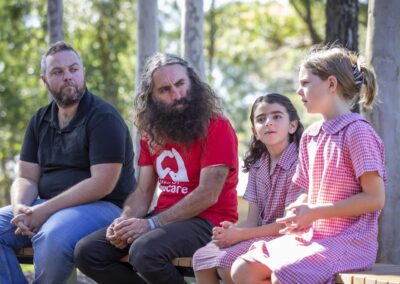
Creating a yarning circle: connecting to Landcare
Time Allocation: 45 mins
Activity Level: Easy
Introduction
In this activity you are going to connect with your local Landcare or other community environment group. Working with your local Landcare or environment group is a great way to access local expertise, support and resources.
Connecting with Landcare can occur at any time during your yarning circle project, from the initial phase when you are selecting your site to set up your yarning circle to enhancing the area around your yarning circle once it has been established.
Landcare doesn’t always need to be a hands-on activity. Immersing children in a yarn or conversation is a great way to build their understanding and awareness of different cultures, landscapes and why it’s important to care for their environment and our natural resources.
Having a yarning circle in your school is also a great focal point for understanding the intricacies of your local landscape, connection to culture and connection to Country. It provides a space for many tangible and intangible connections that you can draw to enrich learning experiences.
Checklist
Instructions
 Step 1
Step 1
Preparation:
In this activity you will be showcasing your yarning circle to your local Landcare or environmental group.
Use the Find a Group directory on the Landcare Australia website if you do not already know who your local group is and invite them to come to your school. If there is no local Landcare group near to your school, contact other environmental organisations working in your area.
Get in touch with your local First Nations representatives or community members who you have been working with and invite them as well. If you do not have any existing contacts or direct links with First Nations organisations or people in your area, a good starting point is to contact either the Local Aboriginal Land Council (LALC) or Local Aboriginal Education Consultative Group.
Note: this activity can be undertaken at any time during the development of your yarning circle project.
 Step 2
Step 2
Identify needs:
Head outside with your students.
Using the Activity Sheet, identify what is working well in your space and what you could use some assistance with from a group such as Landcare.
Examples include:
- Help sourcing and planting Indigenous plants around the yarning circle
- Identifying the plants and animals in the area around the yarning circle
- Weeding/weed removal.
 Step 3
Step 3
Present:
Begin this activity with an Acknowledgement of Country. By acknowledging the Land, you are also making a promise that you will recognise the cultural practices of First Nations people.
As a team, present to your invited guests.
Explain what you have set out to achieve, what has worked well and what you think you would like some assistance with to enhance your yarning circle and the surrounding area.
Ask for suggestions and thoughts on things you may not have considered.
 Step 4
Step 4
Sharing:
Have a conversation between your students, the Landcare members and/or the First Nations representatives or community members who have come to your school.
Think about:
- How you can work together?
- What assistance/expertise Landcare can provide?
- Other resources you could develop/share?
Extension Activity
Media release: Write a media release for your local newspaper/publication telling them about what you have achieved, learnt and what you are going to do next with your yarning circle.